(print this out and take it with you on your next visit to Perth)
Perth Tour 1 Perth Tour 2 Perth Tour 3 Perth Tour 4
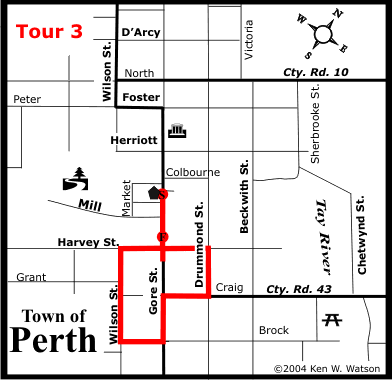 |
Original walking tour pamphlet designed by the Perth Local Architectural Conservation Advisory Committee |
Perth - Centre Ward
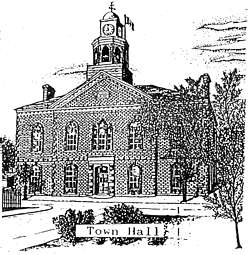 The Town Hall - 1863. Constructed from locally quarried Potsdam sandstone, this Neo-classical structure once housed a concert hall in addition to the public offices, and the Perth Citizens' Band room, located upstairs at the rear of the building. The Town Hall - 1863. Constructed from locally quarried Potsdam sandstone, this Neo-classical structure once housed a concert hall in addition to the public offices, and the Perth Citizens' Band room, located upstairs at the rear of the building.
Proceed east on Gore Street towards the Tay River.
Locke's Bridge. The first bridge on this site was a giant elm tree felled by early settler Mangus Flett, to connect Cockburn Island with Brockville Road. Since then several other bridges have stood here including a stone arched bridge which was changed to a swing bridge in 1890 giving steamer access to Haggart's Mill, a quarter mile upstream. The present bridge, erected in 1957, is now called the Gore Bridge.
106 Gore St. East. In 1830 a stone building was erected here as a brewery. From 1851-1917 it was the site of the Spalding & Stewart Distillery. Circa 1917 the Gore Street section was demolished, and the remaining section now has a paint shop and apartments.
118 Gore St. East. From 1840-1884 this housed Stewards Hotel.
Proceed back to Harvey Street.
Morris House (on corner). In 1817 this was the site of the first store. In 1843 a 2 storey stone building was erected and used by various merchants until 1908. From 1908-1919 it was used as St. John's Hall. From 1920-1931 it was used by various merchants and from 1931 on, it has been used as the present apartments.
39 Harvey St. From 1860-1900 - a single storey brick building, the home of The East Ward Fire Department.
42 Harvey St. In 1840 the structure was erected. From 1880 to 1886, E. Connoly, Grocer, used it. Since 1887 it has been a private residence.
Proceed to corner of Wilson St. and turn left to school.
St. John's Elementary School, 1926 - the site of two previous wooden schools. The original structure has had two subsequent additions to accommodate increased enrolment.
Proceed diagonally from School facing onto Craig Street.
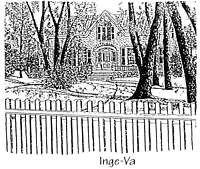 Inge Va, circa 1823 - Erected by the Rev. Michael Harris, Rector of the Perth Military Settlement. It is a superb example of the Colonial Georgian style so popular at this time. It was the home of Robert Lyon, a young law student, who was fatally wounded in the Last Duel fought in Ontario. It was named Inge-Va (Tamil for "come here") by the third owner, Ella Inderwick, who purchased the property from the Radenhurst family in the 1890s. The Inderwicks had previously lived in Ceylon. Inge Va, circa 1823 - Erected by the Rev. Michael Harris, Rector of the Perth Military Settlement. It is a superb example of the Colonial Georgian style so popular at this time. It was the home of Robert Lyon, a young law student, who was fatally wounded in the Last Duel fought in Ontario. It was named Inge-Va (Tamil for "come here") by the third owner, Ella Inderwick, who purchased the property from the Radenhurst family in the 1890s. The Inderwicks had previously lived in Ceylon.
St. John’s Convent (adjacent to the School on Wilson Street) - Erected in 1905 to house the Sisters teaching School. From 1985-1992 it was used as St. John's High School until a more suitable building was erected on the Scotch Line. Since 1993 it has been used as a Parish Centre and by St. John's School.
St. John's Rectory - Erected in 1856 as a Priests' House and changed very little since then.
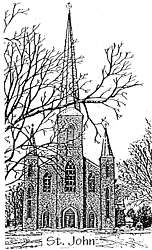 St. John the Baptist Roman Catholic Church - Erected in 1848, with an addition in 1899 to accommodate new altars and more seating. It is the oldest church structure in Perth, and was located outside the original Town limits. The land for the church was donated by an Anglican, Dr Alexander Thorn, Perth's first surgeon. The church is noted for its vaulted ceilings, stained glass windows, Stations of the Cross and pews scaled to the smaller physiques of the 1800s. St. John the Baptist Roman Catholic Church - Erected in 1848, with an addition in 1899 to accommodate new altars and more seating. It is the oldest church structure in Perth, and was located outside the original Town limits. The land for the church was donated by an Anglican, Dr Alexander Thorn, Perth's first surgeon. The church is noted for its vaulted ceilings, stained glass windows, Stations of the Cross and pews scaled to the smaller physiques of the 1800s.
Turn left at Brock Street and proceed to Gore Street.
168 Gore St. East, 1831 - used as a Methodist Manse by various clergy until the early 1900s. It is an excellent example of Pre-Confederation architecture in the Upper St. Lawrence style.
160 Gore St. East, 1850s - a stone building was erected. From 1860 to 1895 it was used as a Blacksmith's shop. From 1933 to 1965 it was used as a grocery store and residence of W.O. Lynn. Since 1965 it has been used as private housing.
144 Gore St. East, 1884 - built and used as a Methodist Church from 1884-1928. From 1928 to 1964 it was used as an armoury. Since 1965 it has been used as the Asbury Free Methodist Church.
At Craig Street turn right.
52 Craig St., 1880s - the brick building was the residence of James Spalding, part owner of Spalding & Stewart Distillery.
50 Craig St., 1850s - used as a Manse and as a private residence.
55 Craig St., "The Red House." 1816 - As the first building in Perth, this oak log structure served as Officers Quarters, Tavern Church, School, Meeting Place and Printing Office. Named from the 1816 visit of the Duke of Richmond who suggested that it be painted red, it has been painted white since 1822.
Proceed to Drummond Street - turn left.
48 Drummond St. East, 1832. From 1832 to 1865 it was the Dennis Kane's Hotel. From 1865 to present it has been used as a residence by descendants of the Kane family (Garrets).
The Perth Bowling Green (across on the corner). Original location of the Presbyterian Church which burned down in 1923.
Registry Office, 1872. From 1872 to 1974 this stone building was the home of the Lanark County Registry Office.
Court House, 1842 - Seat of Government for the District of Bathurst and later Lanark County. Justice has been dispensed from this site since 1820. The County Gaol, now closed, but formerly used for executions, is on Beckwith Street, behind the Court House.
38 Drummond St. East, 1830s - The Benjamin Delisle house, an early merchant, with many different occupants to the present.
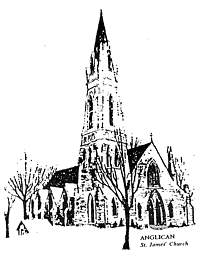 St James The Apostle, Anglican Church, 1861 - Designed by the architects of the original Parliament Buildings in Ottawa, this Royal Charter Church was built to be the district's Cathedral, on the site of the Garrison Church. The columns supporting the vaulted ceilings are solid pine. The intricately carved screens and the stained glass windows are of the highest quality, and regimental flags are proudly displayed. St James The Apostle, Anglican Church, 1861 - Designed by the architects of the original Parliament Buildings in Ottawa, this Royal Charter Church was built to be the district's Cathedral, on the site of the Garrison Church. The columns supporting the vaulted ceilings are solid pine. The intricately carved screens and the stained glass windows are of the highest quality, and regimental flags are proudly displayed.
The Summit House. Circa 1823 - Similar in construction to "The Grange" at the Art Gallery of Ontario, it was built using local bricks by James Boulton, an early Perth Lawyer. Miss Elizabeth Hughes, over whom the Last Fatal Duel was fought, lived here as Governess, while John Wilson, the Duel's survivor, articled for Mr. Boulton.
30 Drummond St. East, 1835. From 1835 to 1860 this was the Coyless Hotel, also known as Farmers Rest. From 1861 to 1992 it was used as a private residence. It was restored in 1992 and is now used as a Bed and Breakfast.
Proceed back to Harvey Street.
15 Harvey St., 1830. A 2 storey house built by Dorans. From 1832 to 1873 it was the St. George Hotel. From 1874 to 1952 it was used as a private residence. From 1953 to 1970 it was used as a Jewish Synagogue and since 1970 it has been used as apartments.
21 Harvey St., 1850. From 1850 to 1874 it was the residence of Captain A. Fraser. Since 1874 it has been the private residence of various owners.
McMartin House (corner of Harvey and Gore Streets), circa 1830. This building was erected by United Empire Loyalist descendant, Daniel McMartin, Perth's third lawyer. Unique to Perth, it was built in the Federalist style which is more common to the Eastern Seaboard of the United States. You can see the "widow's walk” at the top of the house. Mrs. McMartin, an American, insisted that all the materials, including the brick, be brought from Syracuse, New York, despite there being many fine local brickyards. From 1830 to 1875 it was Daniel McMartin’s residence. From 1875 to 1919 it was the office and residence of Dr. Grant. From 1919 to 1970 it was used as the Parish Hall for St. John The Baptist Church. In 1971 the Ontario Heritage Foundation restored the building for use as a Seniors' Activity Centre and for meetings.
105-107-109 Gore St. East, 1840. The site of the King's Store during the initial settlement of Perth in 1816. In 1840 this fine stone building was erected by James Allen, Postmaster from 1842 to 1852. 105-107 Gore St. East are presently private residences. 109 Gore St. East has seen various merchants over the years.
Jamieson's Lane (by the River). Has two 1860s private residences.
This walking tour was designed by the Perth Local Architectural Conservation Advisory Committee (LACAC). n.d.
Digital versions created in 2004 by Ken W. Watson.
|